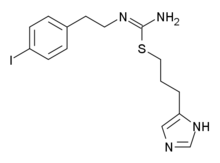| Revision as of 23:30, 5 December 2010 editCitation bot (talk | contribs)Bots5,427,461 editsm Citations: added: last1, first1, last2, first2, last3, first3, last4, first4, last5, first5, last6, first6, last7, first7, last8, first8, title, journal, volume, issue, pages, year, pmc. Rjwilmsi← Previous edit | Revision as of 03:49, 19 April 2011 edit undoCheMoBot (talk | contribs)Bots141,565 edits Updating {{chembox}} (no changed fields - added verified revid - updated 'UNII_Ref', 'ChemSpiderID_Ref', 'StdInChI_Ref', 'StdInChIKey_Ref', 'ChEMBL_Ref', 'KEGG_Ref') per Chem/Drugbox validation (Next edit → | ||
| Line 1: | Line 1: | ||
| {{chembox | {{chembox | ||
| | verifiedrevid = 400753856 | |||
| |ImageFile=Iodophenpropit.png | |ImageFile=Iodophenpropit.png | ||
| |ImageSize=220px | |ImageSize=220px | ||
Revision as of 03:49, 19 April 2011

| |
| Names | |
|---|---|
| IUPAC name 3-(1H-imidazol-5-yl)propyl N'-imidothiocarbamate | |
| Other names 1--N'-formamidine | |
| Identifiers | |
| CAS Number | |
| 3D model (JSmol) | |
| MeSH | Iodophenpropit |
| PubChem CID | |
| CompTox Dashboard (EPA) | |
SMILES
| |
| Properties | |
| Chemical formula | C15H19IN4S |
| Molar mass | 414.30763 |
| Except where otherwise noted, data are given for materials in their standard state (at 25 °C , 100 kPa).
| |
Iodophenpropit is a histamine antagonist which binds selectively to the H3 subtype. Its I radiolabelled form is used for mapping the distribution of H3 receptors in the body.
References
- Jansen, FP; Wu, TS; Voss, HP; Steinbusch, HW; Vollinga, RC; Rademaker, B; Bast, A; Timmerman, H (1994). "Characterization of the binding of the first selective radiolabelled histamine H3-receptor antagonist, 125I-iodophenpropit, to rat brain". British journal of pharmacology. 113 (2): 355–62. PMC 1510107. PMID 7834183.
- Jansen, FP; Mochizuki, T; Maeyama, K; Leurs, R; Timmerman, H (2000). "Characterization of histamine H3 receptors in mouse brain using the H3 antagonist 125Iiodophenpropit". Naunyn-Schmiedeberg's archives of pharmacology. 362 (1): 60–7. PMID 10935534.
This pharmacology-related article is a stub. You can help Misplaced Pages by expanding it. |